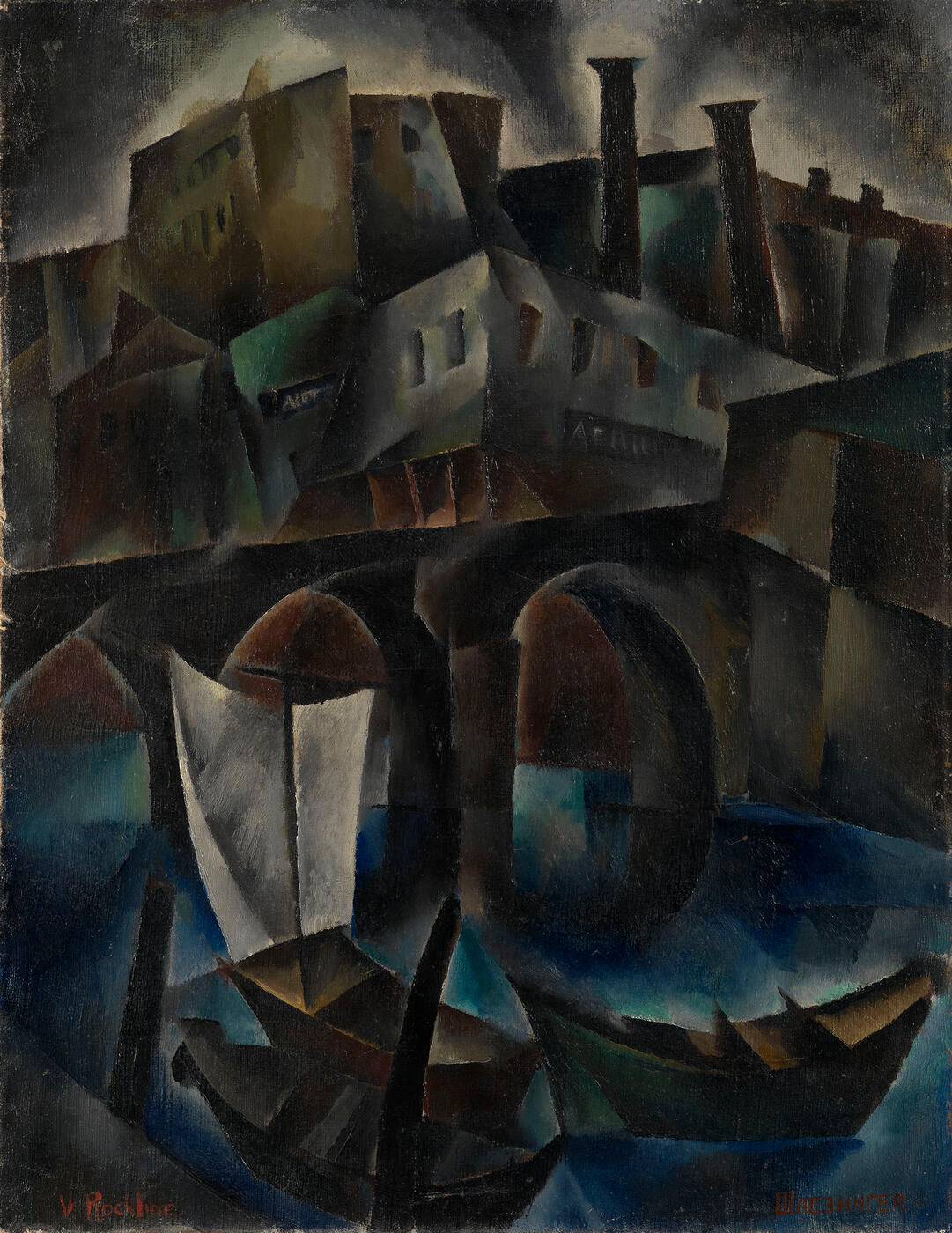MacDougall's Russian Art Auctions 27-30 May 2012
27 May 2012

10. ROCKLINE, VERA (1896-1934)
Vue de Tiflis, signed "V. Rockline", also signed "Schlesinger" in Cyrillic.
Oil on canvas, 97.5 by 75.5 cm.
300,000–400,000 GBP
Provenance: Anonymous sale; Important Russian Pictures, Christie’s London, 28 November 2007, Lot 425.
Private collection, UK.
Exhibited: Rétrospective Vera Rockline, Galerie Drouart, Paris, 1984 (label and stamp on the stretcher).
Femmes et Muses des Impressionnistes aux Modernes, Tokyo, Osaka and elsewhere, 1996–1997, No. 47.
Elles de Montparnasse, Musée de Montparnasse, Paris, 12 April–4 August 2002.
Literature: Exhibition catalogue, Femmes et Muses des Impressionnistes aux Modernes, 1996, p. 77, No. 47, illustrated,
titled Paysage de Tiflis.
Vue de Tiflis is one of the very few known works of Vera Rockline’s Russian period. The artist developed a passion for painting Cubist townscapes in the late 1910s under the influence of Alexandra Exter, her tutor in Kiev, whose studio the young artist, still bearing her maiden name Schlesinger, joined in 1918 after her parents moved there from Moscow. Before this, the young woman had been studying in Moscow at Ilya Mashkov’s studio of drawing and painting where, according to her contemporaries, she painted Neo-impressionist work of which little is now known.
In the years 1918–1919, still under the name of Schlesinger, the artist took part in the Moscow Fellowship of Artists’ 24th exhibition; the 2nd exhibition of pictures by the Artists’ Union, the exhibition of Jewish artists’ painting and sculpture; and the 5th National Exhibition of painting From Impressionism to Non-objectivity. In the same year, however, the artist married and left with her new husband for Georgia. In 1919–1920 Rockline lived in Tiflis, where she created a small series of paintings and drawings of the city.
In these works, the images of Tiflis are created using precise, sculpturally shaped volumes, and it seems as if all it would take is just one detail, one component, to be removed for gaps to open up and the whole thing to collapse. However, Rockline’s Cubism never crosses the line into complete freedom of form. Her paintings of this time are restrainedly Cubist and somewhat
unreal: although possibly less free in their structure than the compositions of Exter, they are finer and more delicate in palette and closer in manner to Cézanne. In the landscapes that she painted in Georgia, the contraposition of masses is not quite so forceful as in her work as a student following in Exter’s footsteps. The connection between the masses is through Cézanne-like transitions that even out the light and dismember volumes into a mosaic of planes turned towards the viewer. In this period Rockline was striving to depict the space between objects rather than accentuating their convexity in the empty
space of traditional perspective. She was interested primarily in the materialisation of that new urban architectural space which she felt in the Georgian capital. For this reason Rockline invariably brings mountains or the Kura River into her urban compositions of Tiflis, acting as a spatial caesura and providing a rhythmic prop for the viewer.
In the present lot, painted in wonderfully harmonious dark blue-greens, browns and blacks, the caesura is the broad watery expanse of the Kura. But in her portrayal of water Rockline’s vision remains Cubist – she breaks down the river’s mass into elements and planes and portrays the restless motion of the water by colliding small flat areas of colour and geometrically compact shapes, rearranged and squeezed together by the strict sculptural and decorative rhythms of the spans of Mikhailovsky Bridge stretching out to Madatovsky Island.
Like the majority of landscapes from this cycle, Vue de Tiflis is deserted, but in no way dead. Although there are no human figures, the boats in the foreground and
the chimneys in the distance are evidence of life going on around. The main emphasis is on the sculptural expressiveness of the shapes. Buildings are vigorously cut up into shining facets, allowing them to be seen from
various viewpoints at the same time. Rockline makes maximum use of opportunities to flatten out space, as ever restricting the depth in perspective of her Cubist structures by a succession of walls or the crested ridge
of a mountain. All this makes Vue de Tiflis one of the most expressive and significant works of Rockline’s early period.
Notes on symbols:
* Indicates 5% Import Duty Charge applies.
Ω Indicates 20% Import Duty Charge applies.
§ Indicates Artist's Resale Right applies.
† Indicates Standard VAT scheme applies, and the rate of 20% VAT will be charged on both hammer price and premium.